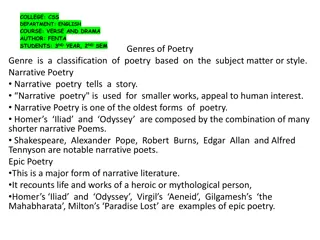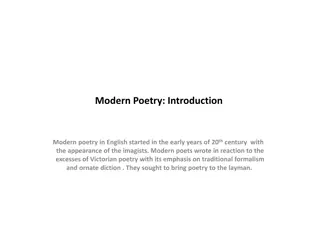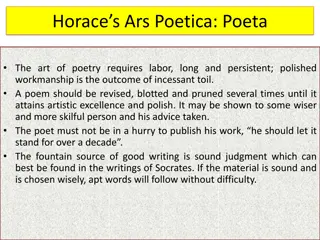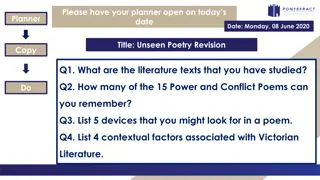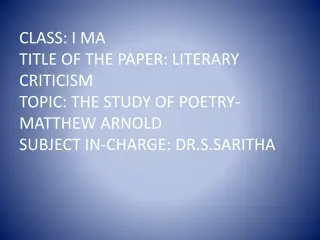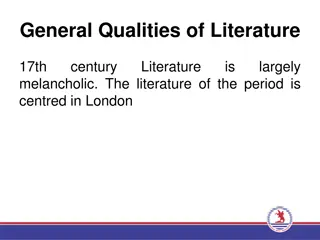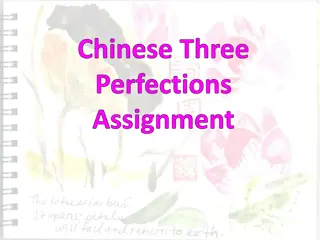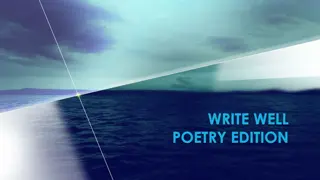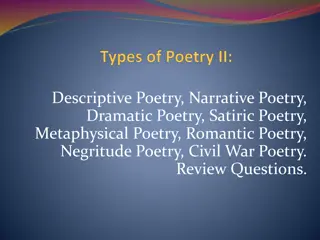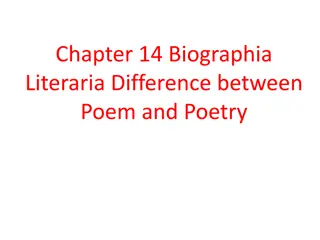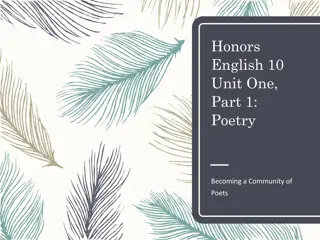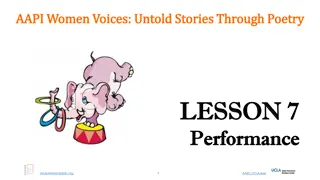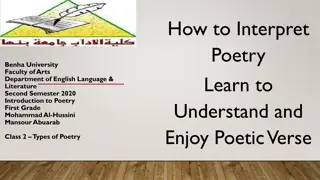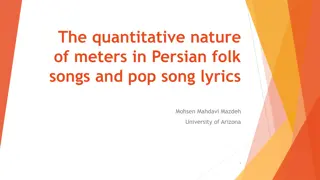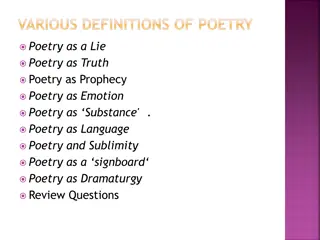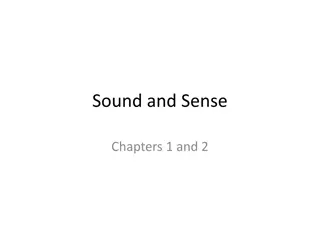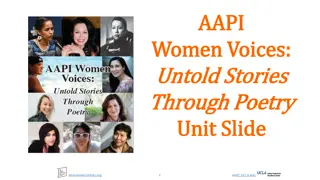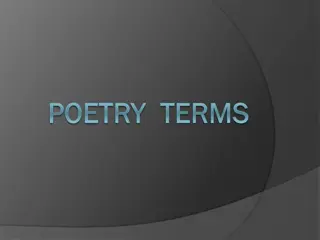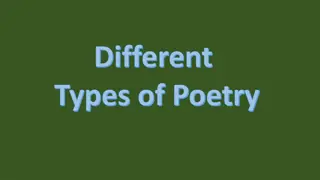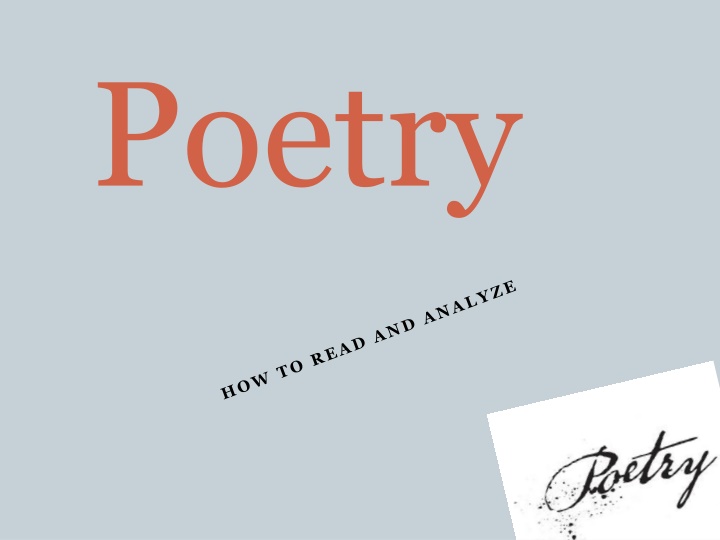
Exploring the Art of Poetry: Elements, Types, and Analysis
Discover the intricate world of poetry with insights into elements like form, types such as lyric and narrative, and how poems are arranged. Delve into the poetic devices that create rhythm, sound effects, and enhance the overall impact of a poem. Learn to analyze poems effectively with a focus on the poet's intentional construction and the meaningful contribution of every word and space.
Download Presentation

Please find below an Image/Link to download the presentation.
The content on the website is provided AS IS for your information and personal use only. It may not be sold, licensed, or shared on other websites without obtaining consent from the author. If you encounter any issues during the download, it is possible that the publisher has removed the file from their server.
You are allowed to download the files provided on this website for personal or commercial use, subject to the condition that they are used lawfully. All files are the property of their respective owners.
The content on the website is provided AS IS for your information and personal use only. It may not be sold, licensed, or shared on other websites without obtaining consent from the author.
E N D
Presentation Transcript
Elements of Poetry Literary form Combines precise meanings of words with emotional associations and musical qualities
Types of Poetry Lyric- short poem that expresses the feelings and thoughts of a SINGLE speaker 2. Narrative- poem that tells a story 1.
Review: Speaker What is a speaker? Can be an imagined character
Review: How is Poetry Arranged? Lines and stanzas Stanzas- grouping of lines (look like a paragraph) Poems are named according to the number of lines they contain. 2- couplet 3- tercet 4- quatrain Quatrain Sweetest love, I do not go, For weariness of thee, Nor in hope the world can show A fitter love for me
Rhythm Language has its own natural rhythm created by our syllables
Sound Devices Techniques that create musical effects Rhyme-sound device most commonly associated with poetry
Other Sound Devices Repetition- the use of any language element more than once- ex: Above the town, above the lake, and high above the trees. Alliteration- the repetition of consonant sounds at the beginning of words- ex: The snake snuck past the snail. Assonance- the repetition of vowel sounds followed by different consonants in two or more stressed syllables- ex: The green leaves fluttered in the breeze.
Sound Devices cont. Consonance- the repetition of final consonant sounds in stressed syllables with different vowel sounds- ex: The king sang a song. Onomatopoeia- use of words to imitate sounds- ex: The bees buzzed, and the brook gurgled.
How to Analyze a Poem Note: these terms work with analyzing poetry, but these are also terms you WILL see on the EOC.
FYI Poets construct poems on purpose. Every word and space has meaning. All aspects of a poem contribute to the meaning. Most poems have several layers to uncover.
Elements to Analyze We look at these parts to determine the meaning of the poem some poets do not use all devices listed. As we investigate each part of the poem, we must ask, Why did the poet use this device? How does it contribute to the poem s meaning? Visual Elements Sound Devices Literal Meaning Figurative Meaning Imagery Historical Context Theme
Visual Elements Before you read, do you notice anything visually about the poem? Is the shape unique? Are there different uses of punctuation?
The Negro Speaks of Rivers Langston Hughes I've known rivers: I've known rivers: I've known rivers ancient as the world and older than the I've known rivers ancient as the world and older than the flow of human blood in human veins. flow of human blood in human veins. My soul has grown deep like the rivers. My soul has grown deep like the rivers. I bathed in the Euphrates when dawns were young. I bathed in the Euphrates when dawns were young. I built my hut near the Congo and it lulled me to sleep. I built my hut near the Congo and it lulled me to sleep. I looked upon the Nile and raised the pyramids I looked upon the Nile and raised the pyramids I heard the singing of the Mississippi when Abe Lincoln I heard the singing of the Mississippi when Abe Lincoln went down to New Orleans, and I've seen its muddy went down to New Orleans, and I've seen its muddy bosom turn all golden in the sunset. bosom turn all golden in the sunset. I've known rivers: I've known rivers: Ancient, dusky rivers. Ancient, dusky rivers. My soul has grown deep like the rivers My soul has grown deep like the rivers.
Emily Dickinson I Never Saw a Moor I NEVER saw a moor- - I never saw the sea- - Yet know I how the heather looks- - And what a wave must be. I never spoke with God - - Nor visited in heaven- - Yet certain am I of the spot- - As if the chart were given This poem makes unique use of conventions--- we call this poetic license. What is the purpose of the hyphens?
Visual Elements Does the poem have a specific number of lines or stanzas? Could this be a specific type of poem (like Haiku?)
Sound Devices Sound devices are elements that a writer makes use of to give his/her poem a pleasing sound Poetry is meant to be read out loud, so it should sound good.
Sound Devices Rhyme is the most obvious lyric device Do You like green eggs and ham? I do not like them Sam-I-am I do not like green eggs And ham.
Sound Devices Another important lyric device is alliteration The repetition of the same sounds. The words in the poem could start or end with the same sound Six sleek swans swam swiftly southwards.
Sound Devices The tide rises, the tide falls, The twilight darkens, the curlew calls; Along the sea-sands damp and brown The traveler hastens toward the town, And the tide rises, the tide falls. Repetition of words or phrases creates certain pattern of cadences of sound. Darkness settles on roofs and walls, But the sea, the sea in darkness calls; The little waves, with their soft, white hands Efface the footprints in the sands, And the tide rises, the tide falls. The morning breaks; the steeds in their stalls Stamp and neigh, as the hostler calls; The day returns, but nevermore Returns the traveler to the shore. And the tide rises, the tide falls. The Tide Rises, the Tide Falls Henry Wadsworth Longfellow
Literal Meaning Poems have many layers of meaning The literal meaning is the first layer What is happening in the poem? What is the poem about? To understand the literal meaning a reader needs to paraphrase (summarize in his/her own words) Long poems must be paraphrased line by line or stanza by stanza in order to be understood.
Figurative Language Figurative devices contribute to a deeper meaning. Metaphors Similes Symbolism
Metaphors and Similes Both of these devices compare objects that are not alike. Metaphor He is a fox. Simile The car is a cell. She runs like the wind. I am hot for her. Clouds like cotton candy. The rain is falling like cats and dogs.
Allusions An allusion is a reference to something outside of what you are reading or viewing. Usually the reference will be mythological, biblical, historical, literary, or from current events. What bird is associated with new births? An act that might let loose many unforeseen and unmanageable problems that might be described as .
Symbols when an object stands for another object or idea. Universal Symbols A symbol that has basically the same meaning to people of various geographies, time periods, and cultures. Particular Symbols A symbol that has an unique meaning to a specific group of people and various meaning depending on the group interpreting it.
Imagery Details which use the five senses to describe a vivid mental picture. Holes in my confidence, holes in the knees of my jeans. -Paul Simon
Imagery Often the imagery helps to create the tone, or mood of a poem. We describe tone with words like lighthearted, somber, suspenseful, etc. The Raven --Edgar Allan Poe Once upon a midnight dreary, While I pondered weak and weary, Over many a quaint and curious Volume of forgotten lore, While I nodded, nearly napping, Suddenly there came a tapping, As of someone gently rapping, Rapping at my chamber door. Tissome visitor, I muttered. tapping at my chamber door; Only this and nothing more. What images can you pick out of this poem? What tone do they evoke?
Historical Context Sometimes, in order to understand a poem, the reader needs to understand the history of the time period during which it was written. Sometimes it is important to know something about the poet in order to get the full impact of the poem s meaning.
Historical Context When lilacs last in the dooryard bloom'd, And the great star early droop'd in the western sky in the night, I mourn'd, and yet shall mourn with ever-returning spring. Ever-returning spring trinity sure to me you bring, Lilac blooming perennial and drooping star in the west, And thought of him I love. --Walt Whitman If the reader didn t know this poem was written about Lincoln s assassination, it wouldn t make as much sense.
So, So, What is the point in What is the point in analyzing poems? analyzing poems?
We analyze poem s to find the meaning. We look at all of the parts to determine the whole. We pick it apart to see what the poet has hidden for us.
When looking for the When looking for the THEME THEME My trick: Theme = The me(ssage) What lesson, truth or message is the poet trying to convey? Usually it can be stated in one sentence. Theme is not the subject. If you can point back to the poem and show where you got the theme, you cannot be wrong. However, some interpretations can be more accurate based on correct interpretation of symbolism, allusion, or other parts of the poem.
Thumb Print I am unique, I will be me. I will strive for success, I will be free. Free of this life, free of what I used to be. I will be me. I will be me. I am who I am, and who I am is proud. I will shoot for the moon, even if all I get is a cloud. I m excited for my future and for what it may hold. I am proud of my words and what they mold. 1. Read the poem. 2. Analyze the poem. What are your first thoughts? What is the speaker trying to tell us? How do you know? Cite examples from the poem.

